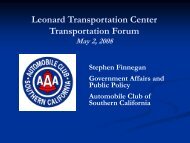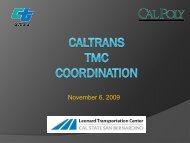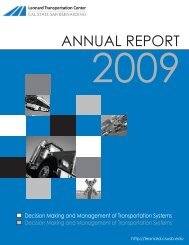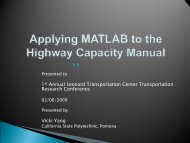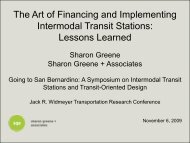Preliminaries to a Feasibility Analysis of the Maglev Proposal of The ...
Preliminaries to a Feasibility Analysis of the Maglev Proposal of The ...
Preliminaries to a Feasibility Analysis of the Maglev Proposal of The ...
Create successful ePaper yourself
Turn your PDF publications into a flip-book with our unique Google optimized e-Paper software.
1.0 Introduction<br />
Preamble<br />
His<strong>to</strong>ry has taught us that as <strong>the</strong> price <strong>of</strong> gasoline continues <strong>to</strong> rise, more and more travelers would find<br />
it more cost effective <strong>to</strong> switch away from single‐ or low‐occupant au<strong>to</strong> travel <strong>to</strong> shared modes in higher<br />
capacity vehicles. Air travel is one <strong>of</strong> those shared modes traditionally suited for long distance travel.<br />
Rail and intercity bus are o<strong>the</strong>r shared modes intuitively suited for medium <strong>to</strong> long distance travel.<br />
Public transit is yet ano<strong>the</strong>r shared mode typically used for short distance and community‐based travel.<br />
Even without shifts <strong>to</strong> higher capacity modes, Sou<strong>the</strong>rn California, like many regions in <strong>the</strong> nation, has<br />
been faced with aviation capacity challenges in a rapidly expanding air travel market. One <strong>of</strong> <strong>the</strong> many<br />
different strategies that agencies are assessing for dealing with capacity issues is <strong>the</strong> idea <strong>of</strong><br />
decentralizing operations in regional aviation markets. <strong>The</strong> idea involves use <strong>of</strong> available or potential<br />
capacity at surrounding secondary or former military airports <strong>to</strong> augment operations at central hub<br />
airports. <strong>The</strong> Sou<strong>the</strong>rn California aviation market, for instance, has nine different commercial aviation<br />
facilities spread out over 38,000 sq. miles.<br />
With a rapidly increasing population, economic expansion, and high levels <strong>of</strong> roadway and air traffic<br />
congestion, <strong>the</strong> Sou<strong>the</strong>rn California Association <strong>of</strong> Governments (SCAG) envisions <strong>the</strong> use <strong>of</strong> <strong>Maglev</strong> (a<br />
variant <strong>of</strong> high speed rail) <strong>to</strong> connect <strong>the</strong> region’s airports and augment <strong>the</strong> transportation<br />
infrastructure. <strong>The</strong> airports <strong>to</strong> be included in <strong>the</strong> SCAG vision are: Los Angeles International Airport<br />
(LAX); Ontario International Airport (ONT); John Wayne‐Santa Ana International Airport (SNA); Bob Hope<br />
– Burbank (BUR); Long Beach (LGB); San Bernardino (SBD); March AFB (MIP); Palm Springs (PSP); and<br />
Sou<strong>the</strong>rn CA Logistics (SCLA).<br />
Rationale for <strong>Maglev</strong> in Sou<strong>the</strong>rn California<br />
Decentralization <strong>of</strong> airport operations should not affect seamlessness in passenger travel. High speed<br />
rail has <strong>the</strong> potential <strong>to</strong> connect <strong>the</strong> airports in <strong>the</strong> Sou<strong>the</strong>rn California region <strong>to</strong> ensure seamless travel<br />
1



